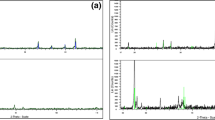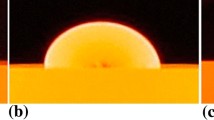Abstract
Sessile drop experiments have been performed in a temperature range between 1090 and 1300° C, aiming to study the wetting of niobium by liquid copper and the influence of different atmospheres (argon, hydrogen, vacuum), crystallographic orientation, roughness, and oxygen doping of niobium on the wetting angle. At the peritectic temperature in the Cu-Nb system (1090° C) the contact angle is high,θ=67°, denoting poor wetting. With increasing temperature,θ decreases steadily for all samples. The wetting is at its lowest for the oxygen-doped samples and at its best for samples annealed under a hydrogen atmosphere. A new mechanism is suggested and discussed for oxygen degassing of niobium through liquid copper.
Similar content being viewed by others
References
W. A. Zisman, in “Contact Angle, Wettability and Adhesion”, Adv. Chem. Sci. No. 43, edited by R. R. Gould (American Chemical Society, Washington, 1964) p. 1.
T. Young,Phil. Trans. Roy. Soc. 95 (1805) 65.
R. E. Johnson Jr,J. Phys. Chem. 63 (1959) 1655.
O. F. De Lima andA. T. De Rezende, to be published.
V. N. Eremenko, Y. V. Naidich andI. A. Lavrinenko, “Liquid-Phase Sintering” (Consultants Bureau, New York, 1970).
R. Roberge, “Superconducting Materials Science”, NATO Advanced Study Institutes Series Vol. 68, edited by S. Foner and B. B. Schwartz (Plenum Press, New York, 1981) p. 389.
E. N. Hodkin, M. G. Nicholas andD. M. Pool,J. Less-Common Metals 20 (1970) 93.
G. M. Zeising,Aust. J. Phys. 6 (1953) 86.
I. A. Popov andN. V. Shirjaeva,Russ. J. Inorg. Chem. 6 (1961) 1184.
C. Allibert, J. Droile andE. Bonnier,Compt. Rend. 268 (1969) 2277.
C. C. Tsuei,J. Mater. Sci. 8 (1973) 1307.
N. Eustathopoulos andD. Pique,Scripta Metall. 14 (1980) 1291.
E. Fromm andE. Gebhardt (editors), “Gase und Kohlenstoff in Metallen” (Springer-Verlag, Berlin, 1976).
C. Herring,Phys. Rev. 82 (1951) 87.
R. N. Wenzel,Ind. Eng. Chem. 28 (1936) 988.
R. Shuttleworth andG. L. J. Bailey,Disc. Faraday Soc. 3 (1948) 16.
R. E. Johnson Jr andR. H. Dettre, in “Contact Angle, Wettability and Adhesion”, Adv. Chem. Ser. No. 43, edited by R. R. Gould (Amer. Chem. Soc., Washington 1964) p. 112.
G. L. J. Bailey andH. C. Watkins,J. Inst. Metals 80 (1951) 57.
J. L. Fihey, P. Nguyen-Duy andR. Roberge,J. Mater. Sci. 11 (1976) 2307.
Author information
Authors and Affiliations
Rights and permissions
About this article
Cite this article
De Lima, O.F., Krehl, M. & Schulze, K. Wetting characteristics of copper on niobium. J Mater Sci 20, 2464–2470 (1985). https://doi.org/10.1007/BF00556075
Received:
Accepted:
Issue Date:
DOI: https://doi.org/10.1007/BF00556075




